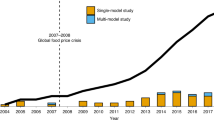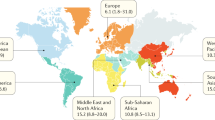Abstract
Objectives:
To examine the association between breastfeeding pattern and growth in the first year of life.
Methods:
A cross-sectional survey was carried out on 349 mothers with infants <12 months in a rural and a semi-urban community in Mangochi district, Malawi. Data on socio-demographic characteristics, infant weight, length and feeding patterns since birth were collected. Multivariate linear regression was performed to test the association between feeding pattern and infant anthropometric status.
Results:
Exclusive breastfeeding (EBF) until 6 months was practised by 13.1% semi-urban and 1.3% rural mothers. No infant was exclusively breastfed beyond 6 months. Breastfeeding was continued among all infants who had stopped EBF. Among infants 6–12 months of age, duration of EBF during the first 6 months was positively associated with length-for-age Z-score (LAZ) (regression coefficient=0.19, 95% confidence interval: 0.06, 0.31) in a model adjusted for socio-demographic factors. Urban residence and female gender yielded positive associations in the same model. The model explained 27% of the variation in LAZ. Among infants <6 months, duration of EBF was not significantly associated with LAZ, but being female and urban residence yielded positive associations. Breastfeeding patterns were not associated with weight-for-age Z-score (WAZ) or weight-for-height Z-score (WLZ) either in the 0–6-month or in the 6–12-month group. Birth outside a health facility was negatively associated with WAZ and WLZ in the older group.
Conclusion:
EBF in the first 6 months of life was associated with increased linear growth, but not weight gain, in later infancy. Promotion of EBF could reduce the prevalence of chronic child undernutrition in the study area.
This is a preview of subscription content, access via your institution
Access options
Subscribe to this journal
Receive 12 print issues and online access
$259.00 per year
only $21.58 per issue
Buy this article
- Purchase on Springer Link
- Instant access to full article PDF
Prices may be subject to local taxes which are calculated during checkout
Similar content being viewed by others
References
UNICEF. Tracking Progress on Child and maternal nutrition, A Survival and Development Priority. UNICEF: New York, NY, USA, 2009.
Pelto GH . Improving complementary feeding practices and responsive parenting as a primary component of interventions to prevent malnutrition in infancy and early childhood. Pediatrics 2000; 106: 1300.
ORC Macro. Nutrition of Young Children and Mothers in Malawi, Findings from the 2004 Malawi Demographic and Health Surveys. Measure DHS: Calverton, MD, USA, 2006.
Hong R, Banta JE, Betancourt JA . Relationship between household wealth inequality and chronic childhood under-nutrition in Bangladesh. Int J Equity Health 2006; 5: 15.
Hong R, Banta JE, Kamau JK . Effect of maternal HIV infection on child survival in Ghana. J Community Health 2007; 32: 21–36.
Maleta K, Virtanen SM, Espo M, Kulmala T, Ashorn P . Childhood malnutrition and its predictors in rural Malawi. Paediatr Perinat Epidemiol 2003; 17: 384–390.
Ramli, Agho KE, Inder KJ, Bowe SJ, Jacobs J, Dibley MJ . Prevalence and risk factors for stunting and severe stunting among under-fives in North Maluku province of Indonesia. BMC Pediatr 2009; 9: 64.
Wamani H, Astrom AN, Peterson S, Tumwine JK, Tylleskar T . Predictors of poor anthropometric status among children under 2 years of age in rural Uganda. Public Health Nutr 2006; 9: 320–326.
WHO. Global Strategy for Infant and Young Child Feeding. WHO: Geneva, Switzerland, 2003.
El TA, Betilmal I, Mahmud SM, Monem AA, Goulet O, Galan P et al. Risk factors for stunting among under-fives in Libya. Public Health Nutr 2009; 12: 1141–1149.
Engebretsen IM, Tylleskar T, Wamani H, Karamagi C, Tumwine JK . Determinants of infant growth in Eastern Uganda: a community-based cross-sectional study. BMC Public Health 2008; 8: 418.
Kramer MS, Kakuma R . The optimal duration of exclusive breastfeeding: a systematic review. Adv Exp Med Biol 2004; 554: 63–77.
Nakamori M, Nguyen XN, Nguyen CK, Cao TH, Nguyen AT, Le BM et al. Nutritional status, feeding practice and incidence of infectious diseases among children aged 6 to 18 months in northern mountainous Vietnam. J Med Invest 2010; 57: 45–53.
Kerr RB, Berti PR, Chirwa M . Breastfeeding and mixed feeding practices in Malawi: timing, reasons, decision makers, and child health consequences. Food Nutr Bull 2007; 28: 90–99.
Kalanda BF, Verhoeff FH, Brabin BJ . Breast and complementary feeding practices in relation to morbidity and growth in Malawian infants. Eur J Clin Nutr 2006; 60: 401–407.
Espo M, Kulmala T, Maleta K, Cullinan T, Salin ML, Ashorn P . Determinants of linear growth and predictors of severe stunting during infancy in rural Malawi. Acta Paediatr 2002; 91: 1364–1370.
National Statistics Office (Malawi), Measure DHS ORC Macro. Malawi Demographic and Health Survey 2004. NSO and ORC Macro: Calverton, MD, USA, 2005.
Maleta K, Virtanen S, Espo M, Kulmala T, Ashorn P . Timing of growth faltering in rural Malawi. Arch Dis Child 2003; 88, 574–578.
Bloss E, Wainaina F, Bailey RC . Prevalence and predictors of underweight, stunting, and wasting among children aged 5 and under in western Kenya. J Trop Pediatr 2004; 50: 260–270.
Hien NN, Kam S . Nutritional status and the characteristics related to malnutrition in children under five years of age in Nghean, Vietnam. J Prev Med Public Health 2008; 41: 232–240.
Khatoon T, Mollah MA, Choudhury AM, Islam MM, Rahman KM . Association between infant- and child-feeding index and nutritional status: results from a cross-sectional study among children attending an urban hospital in Bangladesh. J Health Popul Nutr 2011; 29: 349–356.
Sawadogo PS, Martin-Prevel Y, Savy M, Kameli Y, Traissac P, Traore AS et al. An infant and child feeding index is associated with the nutritional status of 6- to 23-month-old children in rural Burkina Faso. J Nutr 2006; 136: 656–663.
Kamudoni P, Maleta K, Shi Z, Holmboe-Ottesen G . Infant feeding practices in the first 6 months and associated factors in a rural and semiurban community in Mangochi District, Malawi. J Hum Lact 2007; 23: 325–332.
Engebretsen IM, Wamani H, Karamagi C, Semiyaga N, Tumwine J, Tylleskar T . Low adherence to exclusive breastfeeding in Eastern Uganda: a community-based cross-sectional study comparing dietary recall since birth with 24-hour recall. BMC Pediatr 2007; 7: 10.
Acknowledgements
The study was funded by the Norwegian Agency for Development Cooperation.
Author information
Authors and Affiliations
Corresponding author
Ethics declarations
Competing interests
The authors declare no conflict of interest.
Additional information
Supplementary Information accompanies this paper on European Journal of Clinical Nutrition website
Supplementary information
Rights and permissions
About this article
Cite this article
Kamudoni, P., Maleta, K., Shi, Z. et al. Exclusive breastfeeding duration during the first 6 months of life is positively associated with length-for-age among infants 6–12 months old, in Mangochi district, Malawi. Eur J Clin Nutr 69, 96–101 (2015). https://doi.org/10.1038/ejcn.2014.148
Received:
Revised:
Accepted:
Published:
Issue Date:
DOI: https://doi.org/10.1038/ejcn.2014.148
This article is cited by
-
Climatic conditions and infant care: implications for child nutrition in rural Ethiopia
Population and Environment (2021)
-
Exploring how and why Care Groups work to improve infant feeding practices in low- and middle-income countries: a realist review protocol
Systematic Reviews (2020)
-
Level of exclusive breastfeeding practice in remote and pastoralist community, Aysaita woreda, Afar, Ethiopia
International Breastfeeding Journal (2019)
-
Maternal determinants of optimal breastfeeding and complementary feeding and their association with child undernutrition in Malawi (2015–2016)
BMC Public Health (2019)
-
Determinants of infant breastfeeding practices in Nepal: a national study
International Breastfeeding Journal (2019)



